I mentioned in the Dane Axe thread that I was working on some pattern welded Anglo Saxon spears. I have finally gotten around to posting up pictures as requested 
Last November, whist at TORM, I was chatting to a chap about pattern welding (the proper name for what is often called damascus if you aren't sure). I mentioned that I fancied having a go at a pattern welded spear, but hadn't found the time to move it from the 'to do some day' list. He instantly pulled a couple of hundred quid from his pocket, slapped it on the table and said "let me know if it is any more" :You_Rock_
All winter I had been planning to get to it, but like Wayland's axe it kept getting pushed back by urgent orders. A few weeks before the next TORM I pulled my finger out and set to work. Now, I have forged smaller spears before and I have made a couple of daggers in the distant past, but I've not made a double edged blade of this size before. I've also never quite perfected welded sockets So before running straight into a labour intensive pw billet, I made a plain spring steel one.
So before running straight into a labour intensive pw billet, I made a plain spring steel one.

The blade is about 8 1/2" long. I cheated a little with the socket and opted for fire welding a piece of steel pipe to a tang on the blade. Initially I forged it into a diamond cross section and ground it that way after heat treating. Then I wondered if I could hollow grind it. I've only ever ground a couple of 3" single edged blades in the past, so wasn't sure how I would manage with 9" and four sides that all need to meet!
That seemed to work OK, so I made a simple patterned head up. I say simple, but these are still multibar pieces. That mean that I make up several 10mm or so square patterned bars, stack them together like a kitkat and then weld them all together. Up to this point I have only made a few multi bar blades, all single edged knives and not for a couple of years. After that is done, the tip has to be forged in without distorting the pattern too much; this involves more slightly tricky welding and forging. If the bars slip out of alignment or the hammer comes down slightly on the pish, then the pattern is distorted or changed. Again, there are symmetry issues here as the bars must line up in the centre when the tip is forged out, also it has to be forged straight and symmetrical to keep it pretty.
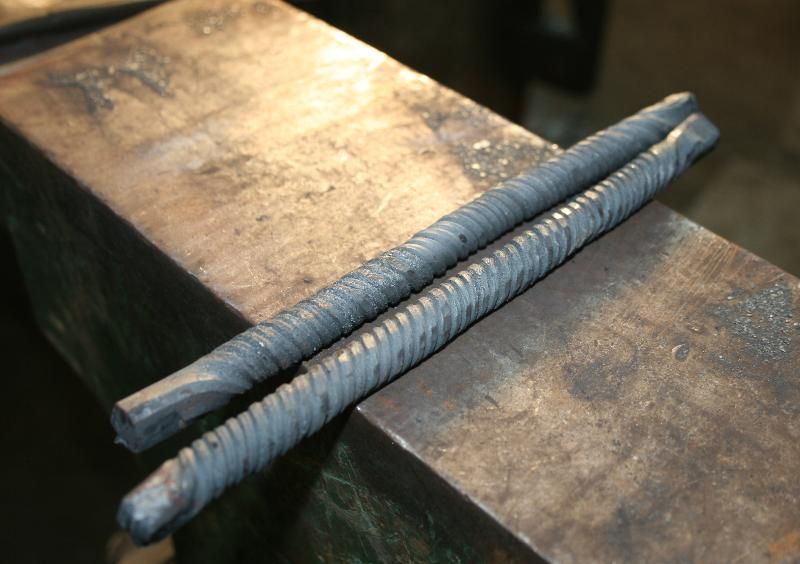

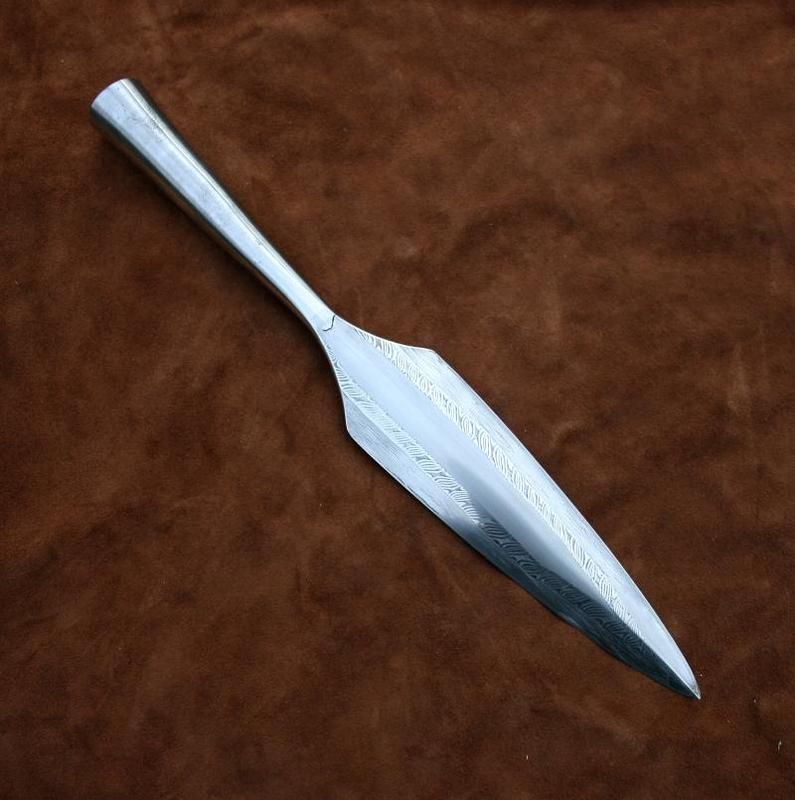
The blade is 9 1/2" long and lenticular in cross section. Edge of EN42, twists of CS80 and 75ni8, core bar of mild steel. Once it was forged to shape I decided that the twisted bars and the edge would come out too narrow compared to the width of the core bar, so I forged the bevels out in order to gain some width in those areas. I went for lenticular (ie convex surfaces on both sides of the blade) because I have never made a blade with this cross section. Not too bad for a first attempt.
Now that I was confident that I could pull it off without cocking it up, I went on and made a couple more complicated ones.
The first has a core of wrought iron (I like the way the iron flows), flanked by twists and then more wrought before edges of EN42. The construction and forging was no more tricky than the last one, but with the extra couple of fingers in the kitkat, twisting and slipping is even more likely. Again, with a piece of pipe welded to the end to give a closed socket. This time I made the bas a little thicker (14mm square) to give me wider stars in the twists and keep a bit more thickness in the blade when finished.
The last spear that I made along side was even more complex, but this time I went with a single piece steel for the core bar and the socket. I went for an open socket for a change. The added difficulty here was the inclusion of 'wolfs teeth' alongside the edge and a high layer (well 400) steel for the edges. A wolfs tooth pattern is like a pair of gears or a zip that are forged together and welded up before applying to the rest of the stack. I had a go at this a few years back with some wrought iron (which flows into the grooves nicely), but not with anything harder. I wish I had done that again instead of using higher carbon steel, but there you go. live and learn!
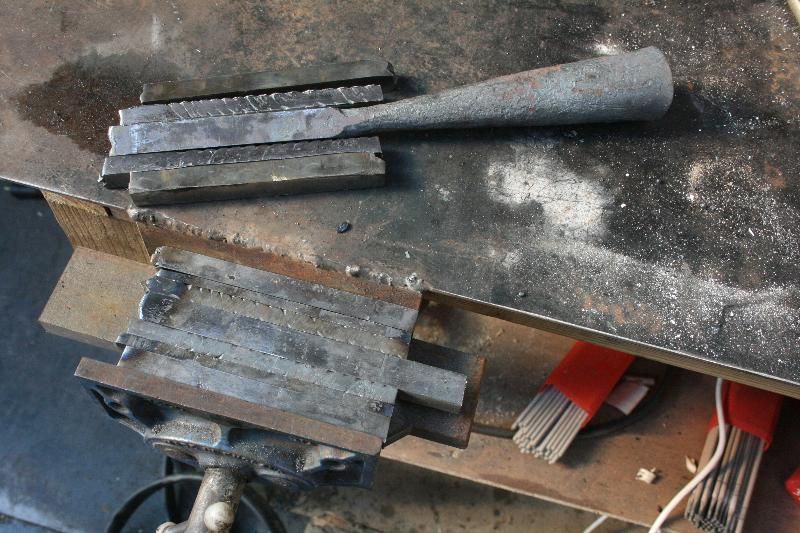
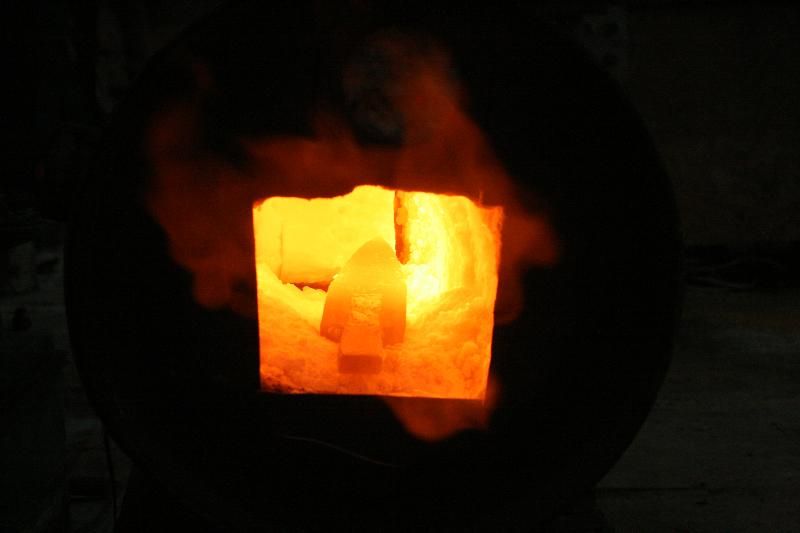
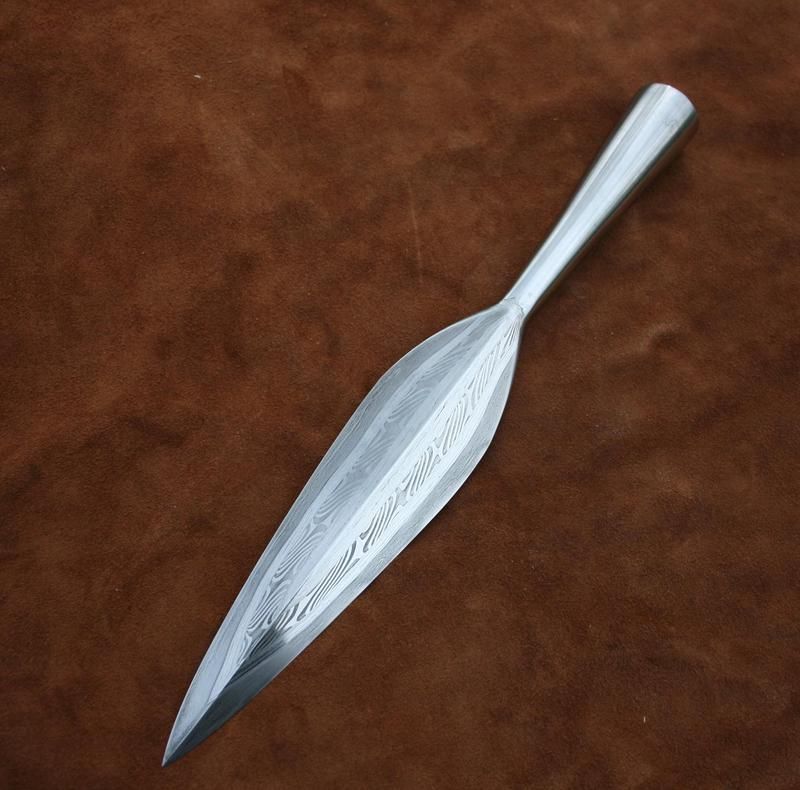
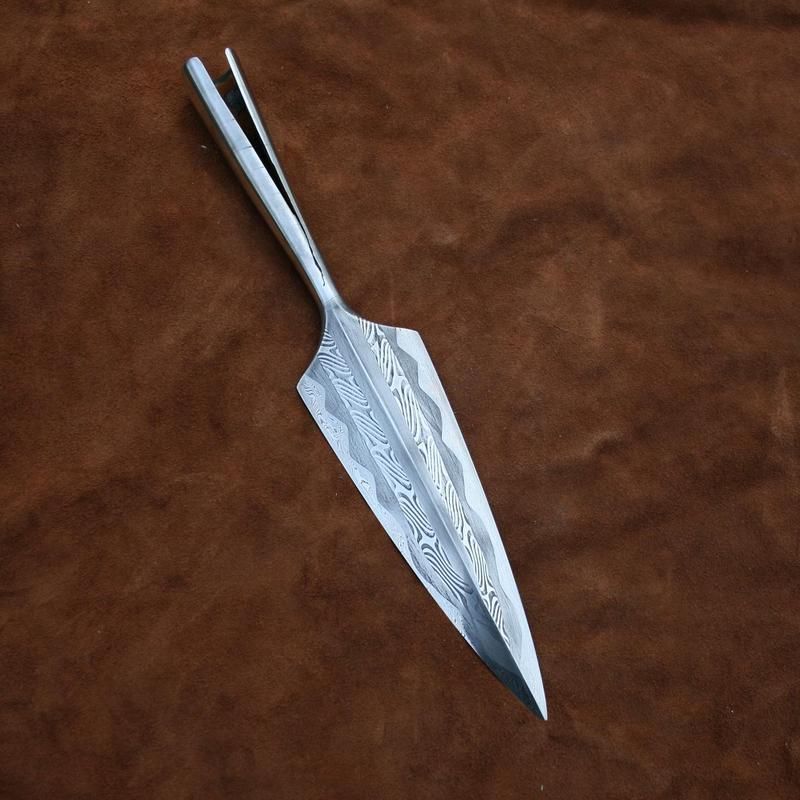
I'll be making a new cutter to do the teeth before I have another crack at that pattern. They are far to open for my liking Still pretty though
Still pretty though  These two are 8" and 7 1/2" blades respectively. Both spears diamond section. I did think about hollow grinding the last on, but didn't want to risk making a mess of it after all that work.
These two are 8" and 7 1/2" blades respectively. Both spears diamond section. I did think about hollow grinding the last on, but didn't want to risk making a mess of it after all that work.
They were a great learning experience and despite them encompassing many aspects that I dislike (such as symmetry, grinding polishing, non-practical objects, unnecessarily posh, etc), they all came out OK and I rather enjoyed making them. Very satisfying when you dip them in acid and see the patterns properly for the first time!
Some more pics

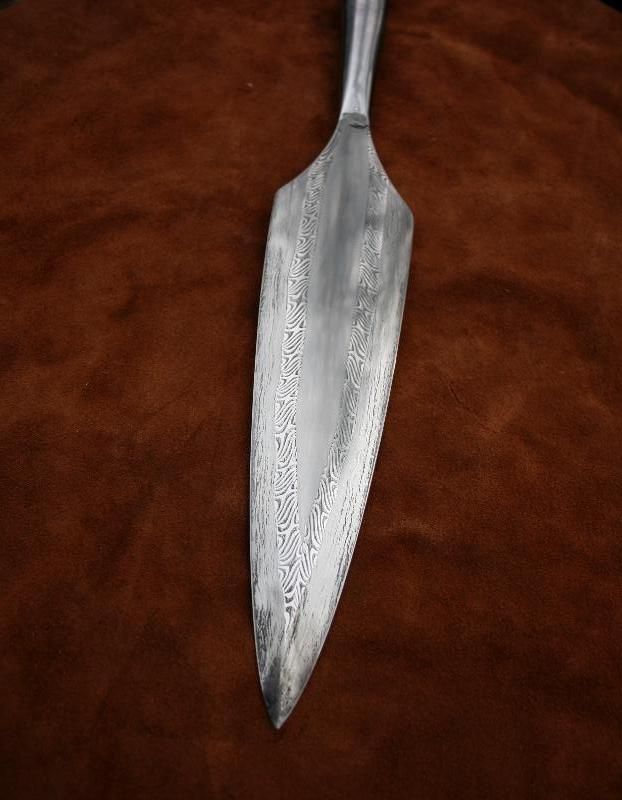
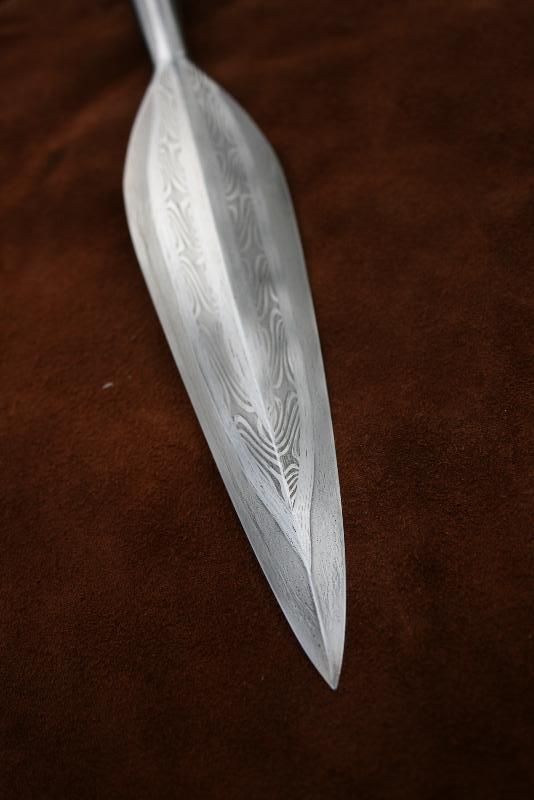
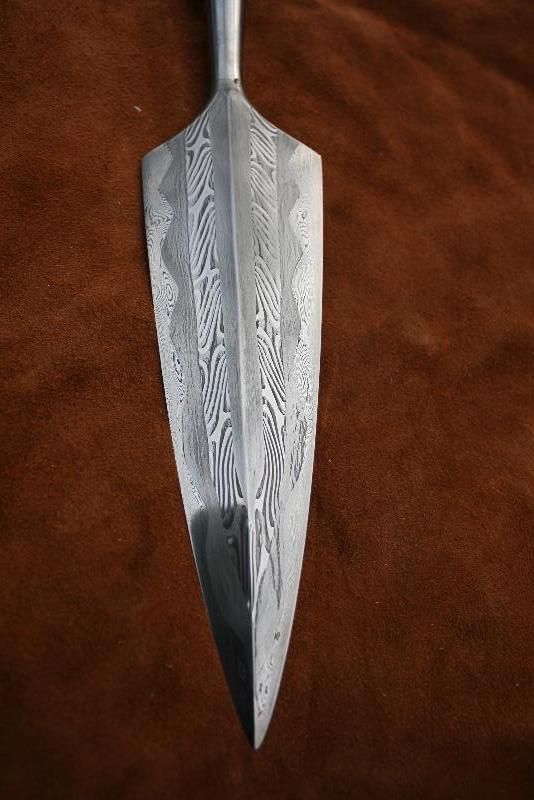
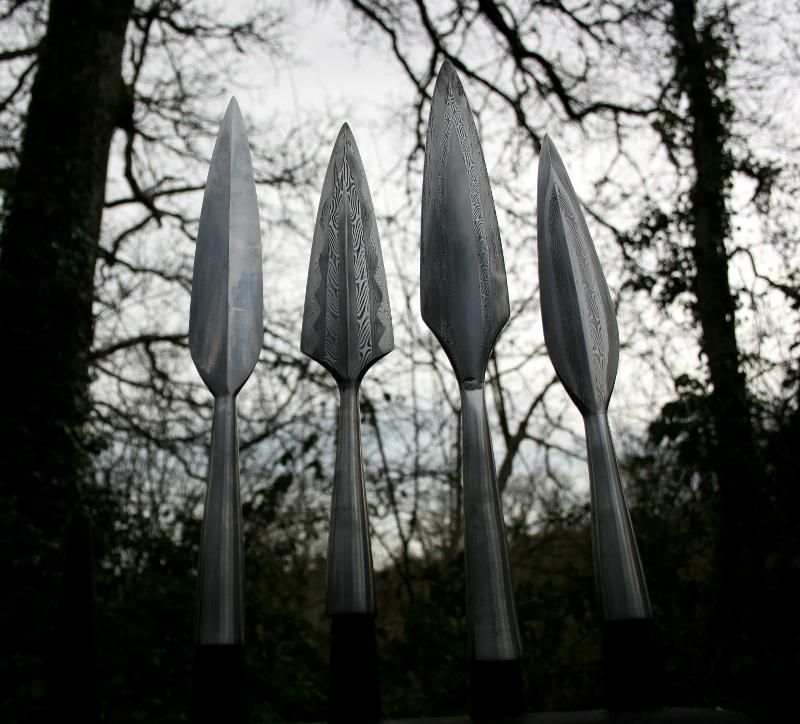
Tanks for looking folks. btw, the customer picked out the last spear head as the one for him
Last November, whist at TORM, I was chatting to a chap about pattern welding (the proper name for what is often called damascus if you aren't sure). I mentioned that I fancied having a go at a pattern welded spear, but hadn't found the time to move it from the 'to do some day' list. He instantly pulled a couple of hundred quid from his pocket, slapped it on the table and said "let me know if it is any more" :You_Rock_
All winter I had been planning to get to it, but like Wayland's axe it kept getting pushed back by urgent orders. A few weeks before the next TORM I pulled my finger out and set to work. Now, I have forged smaller spears before and I have made a couple of daggers in the distant past, but I've not made a double edged blade of this size before. I've also never quite perfected welded sockets

The blade is about 8 1/2" long. I cheated a little with the socket and opted for fire welding a piece of steel pipe to a tang on the blade. Initially I forged it into a diamond cross section and ground it that way after heat treating. Then I wondered if I could hollow grind it. I've only ever ground a couple of 3" single edged blades in the past, so wasn't sure how I would manage with 9" and four sides that all need to meet!
That seemed to work OK, so I made a simple patterned head up. I say simple, but these are still multibar pieces. That mean that I make up several 10mm or so square patterned bars, stack them together like a kitkat and then weld them all together. Up to this point I have only made a few multi bar blades, all single edged knives and not for a couple of years. After that is done, the tip has to be forged in without distorting the pattern too much; this involves more slightly tricky welding and forging. If the bars slip out of alignment or the hammer comes down slightly on the pish, then the pattern is distorted or changed. Again, there are symmetry issues here as the bars must line up in the centre when the tip is forged out, also it has to be forged straight and symmetrical to keep it pretty.



The blade is 9 1/2" long and lenticular in cross section. Edge of EN42, twists of CS80 and 75ni8, core bar of mild steel. Once it was forged to shape I decided that the twisted bars and the edge would come out too narrow compared to the width of the core bar, so I forged the bevels out in order to gain some width in those areas. I went for lenticular (ie convex surfaces on both sides of the blade) because I have never made a blade with this cross section. Not too bad for a first attempt.
Now that I was confident that I could pull it off without cocking it up, I went on and made a couple more complicated ones.
The first has a core of wrought iron (I like the way the iron flows), flanked by twists and then more wrought before edges of EN42. The construction and forging was no more tricky than the last one, but with the extra couple of fingers in the kitkat, twisting and slipping is even more likely. Again, with a piece of pipe welded to the end to give a closed socket. This time I made the bas a little thicker (14mm square) to give me wider stars in the twists and keep a bit more thickness in the blade when finished.
The last spear that I made along side was even more complex, but this time I went with a single piece steel for the core bar and the socket. I went for an open socket for a change. The added difficulty here was the inclusion of 'wolfs teeth' alongside the edge and a high layer (well 400) steel for the edges. A wolfs tooth pattern is like a pair of gears or a zip that are forged together and welded up before applying to the rest of the stack. I had a go at this a few years back with some wrought iron (which flows into the grooves nicely), but not with anything harder. I wish I had done that again instead of using higher carbon steel, but there you go. live and learn!




I'll be making a new cutter to do the teeth before I have another crack at that pattern. They are far to open for my liking
They were a great learning experience and despite them encompassing many aspects that I dislike (such as symmetry, grinding polishing, non-practical objects, unnecessarily posh, etc), they all came out OK and I rather enjoyed making them. Very satisfying when you dip them in acid and see the patterns properly for the first time!
Some more pics





Tanks for looking folks. btw, the customer picked out the last spear head as the one for him

 i wish i'd be able to create something like this! are they just for decoration or will they be used(for reenacting)?!
i wish i'd be able to create something like this! are they just for decoration or will they be used(for reenacting)?!